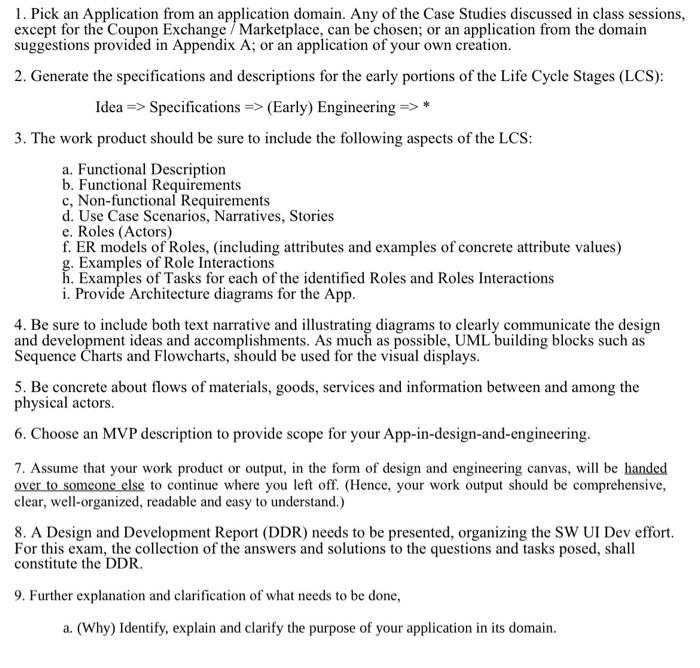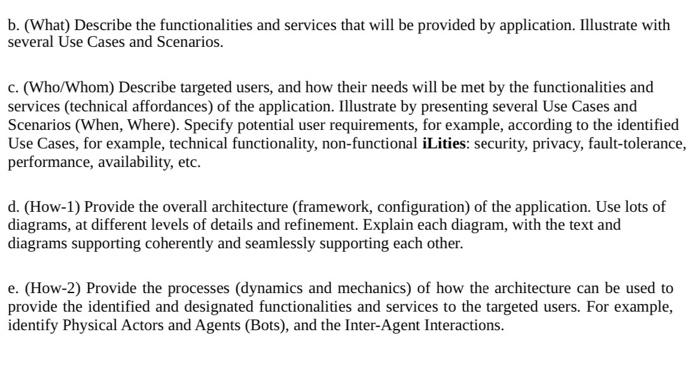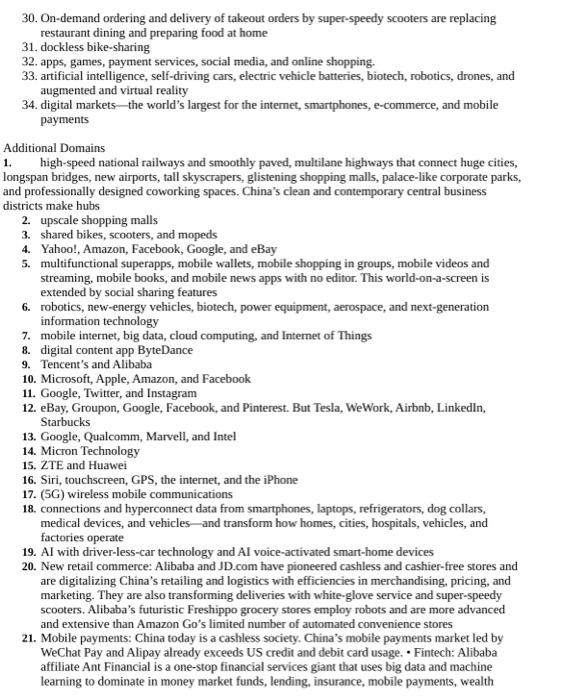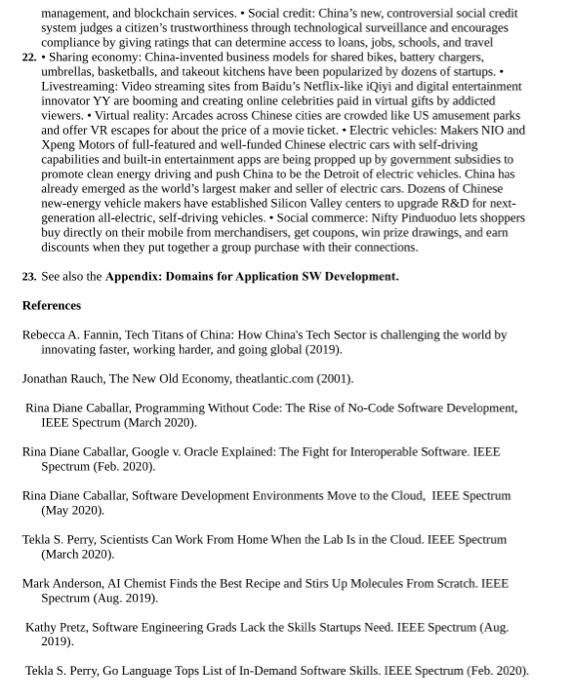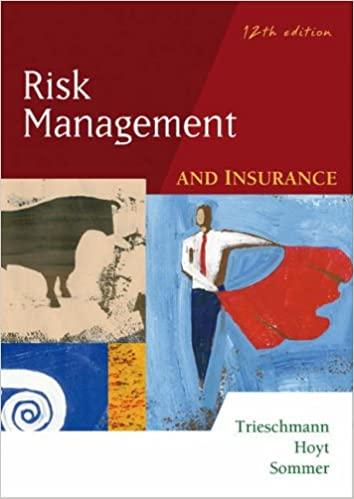
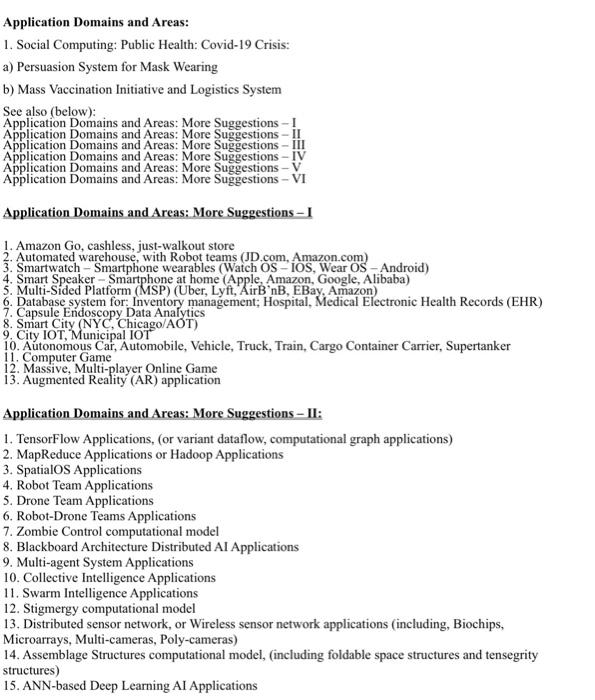
1. Pick an Application from an application domain. Any of the Case Studies discussed in class sessions, except for the Coupon Exchange / Marketplace, can be chosen; or an application from the domain suggestions provided in Appendix A; or an application of your own creation. 2. Generate the specifications and descriptions for the early portions of the Life Cycle Stages (LCS): Idea => Specifications -> (Early) Engineering => 3. The work product should be sure to include the following aspects of the LCS: a. Functional Description b. Functional Requirements C, Non-functional Requirements d. Use Case Scenarios, Narratives, Stories e. Roles (Actors) f. ER models of Roles, (including attributes and examples of concrete attribute values) g. Examples of Role Interactions h. Examples of Tasks for each of the identified Roles and Roles Interactions i. Provide Architecture diagrams for the App. 4. Be sure to include both text narrative and illustrating diagrams to clearly communicate the design and development ideas and accomplishments. As much as possible, UML building blocks such as Sequence Charts and Flowcharts, should be used for the visual displays. 5. Be concrete about flows of materials, goods, services and information between and among the physical actors. 6. Choose an MVP description to provide scope for your App-in-design-and-engineering. 7. Assume that your work product or output, in the form of design and engineering canvas, will be handed over to someone else to continue where you left off. (Hence, your work output should be comprehensive, clear, well-organized, readable and easy to understand.) 8. A Design and Development Report (DDR) needs to be presented, organizing the SW UI Dev effort. For this exam, the collection of the answers and solutions to the questions and tasks posed, shall constitute the DDR. 9. Further explanation and clarification of what needs to be done, a. (Why) Identify, explain and clarify the purpose of your application in its domain. b. (What) Describe the functionalities and services that will be provided by application. Illustrate with several Use Cases and Scenarios. C. (Who/Whom) Describe targeted users, and how their needs will be met by the functionalities and services (technical affordances) of the application. Illustrate by presenting several Use Cases and Scenarios (When, Where). Specify potential user requirements, for example, according to the identified Use Cases, for example, technical functionality, non-functional iLities: security, privacy, fault-tolerance, performance, availability, etc. d. (How-1) Provide the overall architecture (framework, configuration) of the application. Use lots of diagrams, at different levels of details and refinement. Explain each diagram, with the text and diagrams supporting coherently and seamlessly supporting each other. e. (How-2) Provide the processes (dynamics and mechanics) of how the architecture can be used to provide the identified and designated functionalities and services to the targeted users. For example, identify Physical Actors and Agents (Bots), and the Inter-Agent Interactions. Focus: Social Computing 1. apps, games, payment services, social media, and online shopping 2. artificial intelligence, self-driving cars, electric vehicle batteries, biotech, robotics, drones, and augmented and virtual reality 3. digital marketsthe world's largest for the internet, smartphones, e-commerce, and mobile payments 4. computational X 5. commercial technology 6. search, ecommerce, and social networking 7. financial, retail, transportation, and mobile communication sectors 8. internet-connected smart homes, and superapps for speedy on-demand takeout lunches, plus 15- second video thrills and Al-fed news 9. self-driving vehicles, facial recognition for public security, and Al technologies for fintech, edtech, and health-care startups 10. sharing economy for hitching a ride has been very bumpy for bike-sharing startup Ofo, but ride- hailing leader Didi has had a good run in beating Uber. Now shared umbrellas, mobile chargers, and even takeout kitchens are here. 11. e-commerce 12. social commerce: combines bargain shopping, games, and social sharing 13. drones and robots 14. passenger-carrying drone 15. robotic vacuum cleaners and window washer 16. superapp WeChat, you can text or chat in groups or one-on-one; transfer cash to peers; pay bills; get a loan within seconds; buy movie tickets; find nearby friends; order groceries; shop for fashions; and post videos, news, emoticons, and photos 17. combines the functions of Facebook, Twitter, Skype, WhatsApp, Instagram, and Amazon. 18. video streaming a 19. facial recognition on city streets for public security checks. 20. mobile payments, e-commerce, electric vehicles, and livestreaming 21. semiconductors that power electronics and smartphones 22. Robin Li, Jack Ma, and Pony Ma (founders of Baidu, Alibaba, and Tencent, respectively) more than they do Amazon's Jeff Bezos, Facebook's Mark Zuckerberg, or Steve Jobs of Apple 23. artificial intelligence, biotech, green energy, robotics, and superfast mobile communications 24. n fifth-generation wireless 25. transportation, commerce, finance, health care, entertainment, and communications 26. virtual gifts, social commerce, AI-powered news and video apps, and onestop superapps 27. giant consumer and enterprise ecosystems of mobile payments, online shopping, deliveries, games, and videos 28. r smart cities, smart homes, smart workplaces, and smart cars 29. electric cars and self-driving, errand-running humanoid robots, and combined AI and big data to improve cancer diagnoses and care 30. On-demand ordering and delivery of takeout orders by super-speedy scooters are replacing restaurant dining and preparing food at home 31. dockless bike-sharing 32. apps, games, payment services, social media, and online shopping, 33. artificial intelligence, self-driving cars, electric vehicle batteries, biotech, robotics, drones, and augmented and virtual reality 34. digital marketsthe world's largest for the internet, smartphones, e-commerce, and mobile payments Additional Domains 1. high-speed national railways and smoothly paved, multilane highways that connect huge cities, longspan bridges, new airports, tall skyscrapers, glistening shopping malls, palace-like corporate parks, and professionally designed coworking spaces. China's clean and contemporary central business districts make hubs 2. upscale shopping malls 3. shared bikes, scooters, and mopeds 4. Yahoo!, Amazon, Facebook, Google, and eBay 5. multifunctional superapps, mobile wallets, mobile shopping in groups, mobile videos and streaming, mobile books, and mobile news apps with no editor. This world-on-a-screen is extended by social sharing features 6. robotics, new-energy vehicles, biotech, power equipment, aerospace, and next-generation information technology 7. mobile internet, big data, cloud computing, and Intemet of Things 8. digital content app ByteDance 9. Tencent's and Alibaba 10. Microsoft, Apple, Amazon, and Facebook 11. Google, Twitter, and Instagram 12. eBay. Groupon, Google, Facebook, and Pinterest. But Tesla, WeWork, Airbnb, Linkedin, Starbucks 13. Google, Qualcomm, Marvell, and Intel 14. Micron Technology 15. ZTE and Huawei 16. Siri, touchscreen, GPS, the internet, and the iPhone 17. (5G) wireless mobile communications 18. connections and hyperconnect data from smartphones, laptops, refrigerators, dog collars, medical devices, and vehicles and transform how homes, cities, hospitals, vehicles, and factories operate 19. Al with driver-less-car technology and Al voice-activated smart-home devices 20. New retail commerce: Alibaba and JD.com have pioneered cashless and cashier-free stores and are digitalizing China's retailing and logistics with efficiencies in merchandising, pricing, and marketing. They are also transforming deliveries with white-glove service and super-speedy scooters, Alibaba's futuristic Freshippo grocery stores employ robots and are more advanced and extensive than Amazon Go's limited number of automated convenience stores 21. Mobile payments: China today is a cashless society. China's mobile payments market led by WeChat Pay and Alipay already exceeds US credit and debit card usage.. Fintech: Alibaba affiliate Ant Financial is a one-stop financial services giant that uses big data and machine learning to dominate in money market funds, lending, insurance, mobile payments, wealth management, and blockchain services. Social credit: China's new, controversial social credit system judges a citizen's trustworthiness through technological surveillance and encourages compliance by giving ratings that can determine access to loans, jobs, schools, and travel 22. Sharing economy: China-invented business models for shared bikes, battery chargers, umbrellas, basketballs, and takeout kitchens have been popularized by dozens of startups. Livestreaming: Video streaming sites from Baidu's Netflix-like iQiyi and digital entertainment innovator YY are booming and creating online celebrities paid in virtual gifts by addicted viewers.. Virtual reality: Arcades across Chinese cities are crowded like US amusement parks and offer VR escapes for about the price of a movie ticket. Electric vehicles: Makers NIO and Xpeng Motors of full-featured and well-funded Chinese electric cars with self-driving capabilities and built-in entertainment apps are being propped up by government subsidies to promote clean energy driving and push China to be the Detroit of electric vehicles. China has already emerged as the world's largest maker and seller of electric cars. Dozens of Chinese new-energy vehicle makers have established Silicon Valley centers to upgrade R&D for next- generation all-electric, self-driving vehicles. Social commerce: Nifty Pinduoduo lets shoppers buy directly on their mobile from merchandisers, get coupons, win prize drawings, and eam discounts when they put together a group purchase with their connections. 23. See also the Appendix: Domains for Application SW Development. References Rebecca A. Fannin, Tech Titans of China: How China's Tech Sector is challenging the world by innovating faster, working harder, and going global (2019). Jonathan Rauch, The New Old Economy, theatlantic.com (2001). Rina Diane Caballar, Programming Without Code: The Rise of No-Code Software Development, IEEE Spectrum (March 2020). Rina Diane Caballar, Google v. Oracle Explained: The Fight for Interoperable Software. IEEE Spectrum (Feb. 2020). Rina Diane Caballar, Software Development Environments Move to the Cloud, IEEE Spectrum (May 2020) Tekla S. Perry, Scientists Can Work From Home When the Lab Is in the Cloud. IEEE Spectrum (March 2020). Mark Anderson, Al Chemist Finds the Best Recipe and Stirs Up Molecules From Scratch. IEEE Spectrum (Aug. 2019) Kathy Pretz, Software Engineering Grads Lack the Skills Startups Need. IEEE Spectrum (Aug. 2019). Tekla S. Perry, Go Language Tops List of In-Demand Software Skills. IEEE Spectrum (Feb. 2020). Robert N. Charette, Inside the Hidden World of Legacy IT Systems. IEEE Spectrum (Aug. 2020). Robert N. Charette, Why Software Fails. IEEE Spectrum (Sep. 2005). Tekla S. Perry, Tech Salaries: Silicon Valley Still Tops but Other Regions Come on Strong IEEE Spectrum (July 2019). Valarie Romero, Educational Resources That Get Students Up to Speed on Advanced Manufacturing and Programming Languages. IEEE Spectrum (Aug. 2019). Tekla S. Perry, The Big Sprawl: Software Engineering Jobs Escape Into New Territories IEEE Spectrum (July 2017). Tekla S. Perry, What Silicon Valley Tech Jobs Pay the Highest Salaries? IEEE Spectrum (Jan 2018). Tekla S. Perry, Here Are the Software Skills That Will Get You the Highest Salary. IEEE Spectrum (March 2017). Application Domains and Areas: 1. Social Computing: Public Health: Covid-19 Crisis: a) Persuasion System for Mask Wearing b) Mass Vaccination Initiative and Logistics System See also (below): Application Domains and Areas: More Suggestions - ! Application Domains and Areas: More Suggestions - II Application Domains and Areas: More Suggestions - !!! Application Domains and Areas: More Suggestions - IV Application Domains and Areas: More Suggestions - V Application Domains and Areas: More Suggestions - VI Application Domains and Areas: More Suggestions - I 1. Amazon Go, cashless, just-walkout store 2. Automated warehouse, with Robot teams (JD.com, Amazon.com) 3. Smartwatch - Smartphone wearables (Watch OS - IOS, Wear OS- Android) 4. Smart Speaker - Smartphone at home (Apple, Amazon, Google, Alibaba) 5. Multi-Sided Platform (MSP) (Uber, Lyft, AirBnB, EBay, Amazon) 6. Database system for: Inventory management; Hospital, Medical Electronic Health Records (EHR) 7. Capsule Endoscopy Data Analytics 8. Smart City (NYC, Chicago/AOT) 9. City IOT, Municipal IOT 10. Autonomous Car, Automobile, Vehicle, Truck, Train, Cargo Container Carrier, Supertanker 11. Computer Game 12. Massive Multi-player Online Game 13. Augmented Reality (AR) application Application Domains and Areas: More Suggestions - II: 1. TensorFlow Applications, (or variant dataflow, computational graph applications) 2. MapReduce Applications or Hadoop Applications 3. SpatialOS Applications 4. Robot Team Applications 5. Drone Team Applications 6. Robot-Drone Teams Applications 7. Zombie Control computational model 8. Blackboard Architecture Distributed Al Applications 9. Multi-agent System Applications 10. Collective Intelligence Applications 11. Swarm Intelligence Applications 12. Stigmergy computational model 13. Distributed sensor network, or Wireless sensor network applications (including, Biochips, Microarrays, Multi-cameras, Poly-cameras) 14. Assemblage Structures computational model, (including foldable space structures and tensegrity structures) 15. ANN-based Deep Learning Al Applications 1. Pick an Application from an application domain. Any of the Case Studies discussed in class sessions, except for the Coupon Exchange / Marketplace, can be chosen; or an application from the domain suggestions provided in Appendix A; or an application of your own creation. 2. Generate the specifications and descriptions for the early portions of the Life Cycle Stages (LCS): Idea => Specifications -> (Early) Engineering => 3. The work product should be sure to include the following aspects of the LCS: a. Functional Description b. Functional Requirements C, Non-functional Requirements d. Use Case Scenarios, Narratives, Stories e. Roles (Actors) f. ER models of Roles, (including attributes and examples of concrete attribute values) g. Examples of Role Interactions h. Examples of Tasks for each of the identified Roles and Roles Interactions i. Provide Architecture diagrams for the App. 4. Be sure to include both text narrative and illustrating diagrams to clearly communicate the design and development ideas and accomplishments. As much as possible, UML building blocks such as Sequence Charts and Flowcharts, should be used for the visual displays. 5. Be concrete about flows of materials, goods, services and information between and among the physical actors. 6. Choose an MVP description to provide scope for your App-in-design-and-engineering. 7. Assume that your work product or output, in the form of design and engineering canvas, will be handed over to someone else to continue where you left off. (Hence, your work output should be comprehensive, clear, well-organized, readable and easy to understand.) 8. A Design and Development Report (DDR) needs to be presented, organizing the SW UI Dev effort. For this exam, the collection of the answers and solutions to the questions and tasks posed, shall constitute the DDR. 9. Further explanation and clarification of what needs to be done, a. (Why) Identify, explain and clarify the purpose of your application in its domain. b. (What) Describe the functionalities and services that will be provided by application. Illustrate with several Use Cases and Scenarios. C. (Who/Whom) Describe targeted users, and how their needs will be met by the functionalities and services (technical affordances) of the application. Illustrate by presenting several Use Cases and Scenarios (When, Where). Specify potential user requirements, for example, according to the identified Use Cases, for example, technical functionality, non-functional iLities: security, privacy, fault-tolerance, performance, availability, etc. d. (How-1) Provide the overall architecture (framework, configuration) of the application. Use lots of diagrams, at different levels of details and refinement. Explain each diagram, with the text and diagrams supporting coherently and seamlessly supporting each other. e. (How-2) Provide the processes (dynamics and mechanics) of how the architecture can be used to provide the identified and designated functionalities and services to the targeted users. For example, identify Physical Actors and Agents (Bots), and the Inter-Agent Interactions. Focus: Social Computing 1. apps, games, payment services, social media, and online shopping 2. artificial intelligence, self-driving cars, electric vehicle batteries, biotech, robotics, drones, and augmented and virtual reality 3. digital marketsthe world's largest for the internet, smartphones, e-commerce, and mobile payments 4. computational X 5. commercial technology 6. search, ecommerce, and social networking 7. financial, retail, transportation, and mobile communication sectors 8. internet-connected smart homes, and superapps for speedy on-demand takeout lunches, plus 15- second video thrills and Al-fed news 9. self-driving vehicles, facial recognition for public security, and Al technologies for fintech, edtech, and health-care startups 10. sharing economy for hitching a ride has been very bumpy for bike-sharing startup Ofo, but ride- hailing leader Didi has had a good run in beating Uber. Now shared umbrellas, mobile chargers, and even takeout kitchens are here. 11. e-commerce 12. social commerce: combines bargain shopping, games, and social sharing 13. drones and robots 14. passenger-carrying drone 15. robotic vacuum cleaners and window washer 16. superapp WeChat, you can text or chat in groups or one-on-one; transfer cash to peers; pay bills; get a loan within seconds; buy movie tickets; find nearby friends; order groceries; shop for fashions; and post videos, news, emoticons, and photos 17. combines the functions of Facebook, Twitter, Skype, WhatsApp, Instagram, and Amazon. 18. video streaming a 19. facial recognition on city streets for public security checks. 20. mobile payments, e-commerce, electric vehicles, and livestreaming 21. semiconductors that power electronics and smartphones 22. Robin Li, Jack Ma, and Pony Ma (founders of Baidu, Alibaba, and Tencent, respectively) more than they do Amazon's Jeff Bezos, Facebook's Mark Zuckerberg, or Steve Jobs of Apple 23. artificial intelligence, biotech, green energy, robotics, and superfast mobile communications 24. n fifth-generation wireless 25. transportation, commerce, finance, health care, entertainment, and communications 26. virtual gifts, social commerce, AI-powered news and video apps, and onestop superapps 27. giant consumer and enterprise ecosystems of mobile payments, online shopping, deliveries, games, and videos 28. r smart cities, smart homes, smart workplaces, and smart cars 29. electric cars and self-driving, errand-running humanoid robots, and combined AI and big data to improve cancer diagnoses and care 30. On-demand ordering and delivery of takeout orders by super-speedy scooters are replacing restaurant dining and preparing food at home 31. dockless bike-sharing 32. apps, games, payment services, social media, and online shopping, 33. artificial intelligence, self-driving cars, electric vehicle batteries, biotech, robotics, drones, and augmented and virtual reality 34. digital marketsthe world's largest for the internet, smartphones, e-commerce, and mobile payments Additional Domains 1. high-speed national railways and smoothly paved, multilane highways that connect huge cities, longspan bridges, new airports, tall skyscrapers, glistening shopping malls, palace-like corporate parks, and professionally designed coworking spaces. China's clean and contemporary central business districts make hubs 2. upscale shopping malls 3. shared bikes, scooters, and mopeds 4. Yahoo!, Amazon, Facebook, Google, and eBay 5. multifunctional superapps, mobile wallets, mobile shopping in groups, mobile videos and streaming, mobile books, and mobile news apps with no editor. This world-on-a-screen is extended by social sharing features 6. robotics, new-energy vehicles, biotech, power equipment, aerospace, and next-generation information technology 7. mobile internet, big data, cloud computing, and Intemet of Things 8. digital content app ByteDance 9. Tencent's and Alibaba 10. Microsoft, Apple, Amazon, and Facebook 11. Google, Twitter, and Instagram 12. eBay. Groupon, Google, Facebook, and Pinterest. But Tesla, WeWork, Airbnb, Linkedin, Starbucks 13. Google, Qualcomm, Marvell, and Intel 14. Micron Technology 15. ZTE and Huawei 16. Siri, touchscreen, GPS, the internet, and the iPhone 17. (5G) wireless mobile communications 18. connections and hyperconnect data from smartphones, laptops, refrigerators, dog collars, medical devices, and vehicles and transform how homes, cities, hospitals, vehicles, and factories operate 19. Al with driver-less-car technology and Al voice-activated smart-home devices 20. New retail commerce: Alibaba and JD.com have pioneered cashless and cashier-free stores and are digitalizing China's retailing and logistics with efficiencies in merchandising, pricing, and marketing. They are also transforming deliveries with white-glove service and super-speedy scooters, Alibaba's futuristic Freshippo grocery stores employ robots and are more advanced and extensive than Amazon Go's limited number of automated convenience stores 21. Mobile payments: China today is a cashless society. China's mobile payments market led by WeChat Pay and Alipay already exceeds US credit and debit card usage.. Fintech: Alibaba affiliate Ant Financial is a one-stop financial services giant that uses big data and machine learning to dominate in money market funds, lending, insurance, mobile payments, wealth management, and blockchain services. Social credit: China's new, controversial social credit system judges a citizen's trustworthiness through technological surveillance and encourages compliance by giving ratings that can determine access to loans, jobs, schools, and travel 22. Sharing economy: China-invented business models for shared bikes, battery chargers, umbrellas, basketballs, and takeout kitchens have been popularized by dozens of startups. Livestreaming: Video streaming sites from Baidu's Netflix-like iQiyi and digital entertainment innovator YY are booming and creating online celebrities paid in virtual gifts by addicted viewers.. Virtual reality: Arcades across Chinese cities are crowded like US amusement parks and offer VR escapes for about the price of a movie ticket. Electric vehicles: Makers NIO and Xpeng Motors of full-featured and well-funded Chinese electric cars with self-driving capabilities and built-in entertainment apps are being propped up by government subsidies to promote clean energy driving and push China to be the Detroit of electric vehicles. China has already emerged as the world's largest maker and seller of electric cars. Dozens of Chinese new-energy vehicle makers have established Silicon Valley centers to upgrade R&D for next- generation all-electric, self-driving vehicles. Social commerce: Nifty Pinduoduo lets shoppers buy directly on their mobile from merchandisers, get coupons, win prize drawings, and eam discounts when they put together a group purchase with their connections. 23. See also the Appendix: Domains for Application SW Development. References Rebecca A. Fannin, Tech Titans of China: How China's Tech Sector is challenging the world by innovating faster, working harder, and going global (2019). Jonathan Rauch, The New Old Economy, theatlantic.com (2001). Rina Diane Caballar, Programming Without Code: The Rise of No-Code Software Development, IEEE Spectrum (March 2020). Rina Diane Caballar, Google v. Oracle Explained: The Fight for Interoperable Software. IEEE Spectrum (Feb. 2020). Rina Diane Caballar, Software Development Environments Move to the Cloud, IEEE Spectrum (May 2020) Tekla S. Perry, Scientists Can Work From Home When the Lab Is in the Cloud. IEEE Spectrum (March 2020). Mark Anderson, Al Chemist Finds the Best Recipe and Stirs Up Molecules From Scratch. IEEE Spectrum (Aug. 2019) Kathy Pretz, Software Engineering Grads Lack the Skills Startups Need. IEEE Spectrum (Aug. 2019). Tekla S. Perry, Go Language Tops List of In-Demand Software Skills. IEEE Spectrum (Feb. 2020). Robert N. Charette, Inside the Hidden World of Legacy IT Systems. IEEE Spectrum (Aug. 2020). Robert N. Charette, Why Software Fails. IEEE Spectrum (Sep. 2005). Tekla S. Perry, Tech Salaries: Silicon Valley Still Tops but Other Regions Come on Strong IEEE Spectrum (July 2019). Valarie Romero, Educational Resources That Get Students Up to Speed on Advanced Manufacturing and Programming Languages. IEEE Spectrum (Aug. 2019). Tekla S. Perry, The Big Sprawl: Software Engineering Jobs Escape Into New Territories IEEE Spectrum (July 2017). Tekla S. Perry, What Silicon Valley Tech Jobs Pay the Highest Salaries? IEEE Spectrum (Jan 2018). Tekla S. Perry, Here Are the Software Skills That Will Get You the Highest Salary. IEEE Spectrum (March 2017). Application Domains and Areas: 1. Social Computing: Public Health: Covid-19 Crisis: a) Persuasion System for Mask Wearing b) Mass Vaccination Initiative and Logistics System See also (below): Application Domains and Areas: More Suggestions - ! Application Domains and Areas: More Suggestions - II Application Domains and Areas: More Suggestions - !!! Application Domains and Areas: More Suggestions - IV Application Domains and Areas: More Suggestions - V Application Domains and Areas: More Suggestions - VI Application Domains and Areas: More Suggestions - I 1. Amazon Go, cashless, just-walkout store 2. Automated warehouse, with Robot teams (JD.com, Amazon.com) 3. Smartwatch - Smartphone wearables (Watch OS - IOS, Wear OS- Android) 4. Smart Speaker - Smartphone at home (Apple, Amazon, Google, Alibaba) 5. Multi-Sided Platform (MSP) (Uber, Lyft, AirBnB, EBay, Amazon) 6. Database system for: Inventory management; Hospital, Medical Electronic Health Records (EHR) 7. Capsule Endoscopy Data Analytics 8. Smart City (NYC, Chicago/AOT) 9. City IOT, Municipal IOT 10. Autonomous Car, Automobile, Vehicle, Truck, Train, Cargo Container Carrier, Supertanker 11. Computer Game 12. Massive Multi-player Online Game 13. Augmented Reality (AR) application Application Domains and Areas: More Suggestions - II: 1. TensorFlow Applications, (or variant dataflow, computational graph applications) 2. MapReduce Applications or Hadoop Applications 3. SpatialOS Applications 4. Robot Team Applications 5. Drone Team Applications 6. Robot-Drone Teams Applications 7. Zombie Control computational model 8. Blackboard Architecture Distributed Al Applications 9. Multi-agent System Applications 10. Collective Intelligence Applications 11. Swarm Intelligence Applications 12. Stigmergy computational model 13. Distributed sensor network, or Wireless sensor network applications (including, Biochips, Microarrays, Multi-cameras, Poly-cameras) 14. Assemblage Structures computational model, (including foldable space structures and tensegrity structures) 15. ANN-based Deep Learning Al Applications
